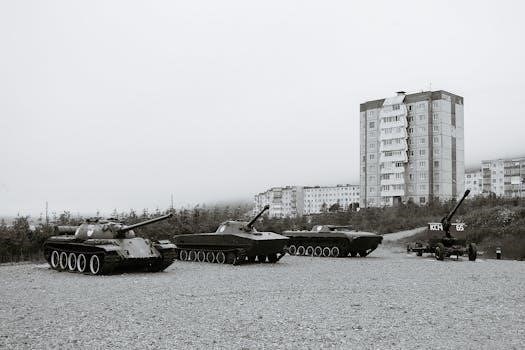

World History The Modern Era Textbook PDF⁚ An Overview
This comprehensive guide explores the significant events and transformative ideas that have shaped the modern world, from the late 18th century to the present day. It offers a detailed examination of global interconnectedness, providing valuable insights into our history. Downloadable PDF versions make this content easily accessible.

Key Features of Modern World History Textbooks
Modern world history textbooks often present a structured exploration of global historical events, typically spanning from the early modern period to contemporary times. They emphasize key civilizations, trade networks, revolutions, and significant turning points. These texts aim to provide students with a global perspective, encouraging critical thinking about historical concepts. Many feature engaging narratives that make complex historical information more accessible and understandable. Furthermore, these textbooks often include supplementary materials such as maps, primary source documents, and timelines to enhance the learning experience. The texts are designed to meet the needs of both majors and non-majors in undergraduate survey courses, providing a solid foundation for further studies. They often incorporate various assessment tools to gauge student comprehension and foster analytical skills. Modern textbooks also tend to highlight the interconnectedness of global events, stressing the importance of understanding history from multiple viewpoints. They are frequently designed to align with state and national curriculum standards. Additionally, the textbooks may feature case studies or examples that highlight specific aspects of the modern era, making learning more focused and impactful. The use of clear and concise language is prioritized to aid in student understanding of sometimes complex historical processes.
Availability of PDF Versions of World History Textbooks
The accessibility of world history textbooks in PDF format has significantly increased in recent years, offering a convenient alternative to traditional print versions. Many publishers and educational resource platforms now provide digital copies of these textbooks, catering to the growing demand for online learning materials. This availability allows students and educators to access comprehensive historical content on various devices, such as computers, tablets, and smartphones, enhancing flexibility in study and teaching. These PDF versions often include interactive features, such as searchable text, embedded links, and multimedia content, that are not available in print copies. Open educational resources (OER) frequently offer free PDF versions of world history textbooks, making quality educational materials accessible to a wider audience. Furthermore, some institutions provide access to digitized textbooks through their online libraries or learning management systems. The ease of downloading and sharing PDF files also facilitates collaborative learning and research. While some may need to convert text into a document, many are readily available. The digital format also addresses the challenge of physical storage and transportation, making these resources particularly beneficial for students studying remotely or with limited access to physical libraries. However, some copyrighted textbooks may require purchase or subscription to access their PDF versions, so it’s important to check terms.

Content Coverage⁚ 18th Century to Present Day
World history textbooks focused on the modern era typically provide comprehensive coverage of the period from the 18th century to the present day. This encompasses a vast array of historical events, movements, and transformations that have shaped the contemporary world. Key topics often include the Enlightenment, the French Revolution, and the Industrial Revolution, which are considered pivotal in the transition to modernity. The texts delve into the rise of nationalism, imperialism, and colonialism, examining their impact on various regions globally. Furthermore, they address the two World Wars, the Cold War, and the subsequent geopolitical shifts. The content extends to cover decolonization, the rise of new global powers, and the ongoing processes of globalization and interconnectedness. These textbooks also explore social, cultural, and economic developments, including the evolution of technology, the growth of cities, and changes in social structures. The study of major ideological movements, such as liberalism, communism, and fascism, is also essential in understanding the political landscape of the era. The textbooks also often include discussion of human rights, social justice movements, and contemporary challenges like environmental issues and global health crises. They aim to provide a balanced perspective on diverse cultures and regions, highlighting both the commonalities and differences in historical experiences across the globe. This thorough approach ensures students gain a nuanced understanding of modern history.
Emphasis on Global Interconnectedness
Modern world history textbooks place a significant emphasis on global interconnectedness, highlighting the ways in which different regions and cultures have influenced each other throughout history. They move beyond a Eurocentric perspective to explore the complex interactions and exchanges between societies across the globe. The texts often examine the impact of trade, migration, and technological advancements in fostering connections between distant lands. They analyze how these interactions have led to the diffusion of ideas, cultural practices, and economic systems. The focus is on how historical events in one part of the world have had repercussions in others, underscoring the interconnected nature of global processes. The textbooks also delve into the formation of global networks and institutions, such as international organizations and trade agreements, which have further integrated the world. They discuss the challenges and opportunities presented by this increasing interconnectedness, including issues like global inequality and environmental sustainability. The rise of globalization as a transformative force is also a prominent theme, with discussions on its economic, social, and cultural dimensions. The texts emphasize the importance of understanding history from a global perspective to grasp the complexity of contemporary issues. By focusing on interconnectedness, these textbooks aim to provide students with a holistic view of the world and the interdependencies that shape our lives.
Textbooks as Open Educational Resources
Many modern world history textbooks are now available as open educational resources (OER), offering free and accessible learning materials to students and educators worldwide. This shift towards OER promotes equitable access to high-quality educational content, reducing the financial burden on students and enabling wider use of these resources. OER textbooks are typically licensed in a way that allows for adaptation and reuse, empowering teachers to tailor the content to their specific classroom needs and learning objectives. This flexibility promotes innovation in teaching practices and encourages the development of diverse pedagogical approaches. The open nature of these textbooks also fosters collaboration among educators, facilitating the sharing of resources and best practices. The availability of PDF versions of OER textbooks allows for easy distribution and use on various devices. This is particularly beneficial for students in remote areas or those with limited access to traditional print materials. OER textbooks are often designed to be inclusive, incorporating diverse perspectives and voices in the historical narrative. They are continuously updated and improved through community contributions, ensuring they remain relevant and accurate. The open licensing model also supports the creation of derivative works, allowing for the development of supplementary materials and multimedia resources. By embracing OER, the educational community is working towards a more accessible, equitable, and collaborative learning environment.
Specific Textbook Examples⁚ Prentice Hall & Others
Several prominent publishers offer world history textbooks focusing on the modern era, with Prentice Hall being a notable example. Their texts, often titled “World History⁚ The Modern Era,” are widely used in secondary and higher education settings. These books typically cover a broad range of topics from the late 18th century to the present, including major political, social, and economic transformations. Other publishers, such as Pearson and various university presses, also produce comprehensive textbooks catering to different academic levels and pedagogical styles. Many of these textbooks are available in digital formats, including PDF versions, enhancing accessibility for students. Some texts are designed for specific courses, such as undergraduate survey courses or Advanced Placement (AP) World History. These textbooks often include supplementary materials like primary source documents, maps, and timelines to enrich the learning experience. The content and organization of these textbooks may vary, reflecting different authors’ interpretations of historical events and themes. Open educational resources (OER) also provide alternative textbook options, allowing educators to adapt and customize the material to suit their needs. When choosing a textbook, educators consider factors such as the text’s coverage, level of detail, pedagogical approach, and cost. Online platforms and library catalogs can assist in locating and comparing different textbook options, ensuring students have access to the most relevant and engaging material.
Focus on Major Global Events and Themes
World history textbooks focusing on the modern era typically emphasize major global events and overarching themes that have shaped the contemporary world. Key events such as the French Revolution, the Industrial Revolution, both World Wars, and the Cold War are extensively covered, examining their causes, consequences, and long-term impacts. The rise of nationalism, imperialism, and decolonization are recurring themes, explored through various case studies and regional examples. Furthermore, the textbooks analyze the development of globalization, including the expansion of trade, technological advancements, and the spread of ideas. Social and cultural changes, such as the rise of modern ideologies, the changing roles of women, and the impact of scientific discoveries, are also given significant attention. The books often discuss the interconnectedness of global events, highlighting how developments in one part of the world have affected others. Additionally, they analyze the evolution of political systems, from monarchies to democracies, and the challenges of governance in a rapidly changing world. The role of international organizations, such as the United Nations, and the ongoing efforts to address global challenges like poverty, inequality, and climate change are also often addressed. By focusing on these major events and themes, textbooks provide a framework for understanding the complex and interconnected nature of modern world history, fostering critical thinking and a global perspective. These textbooks often use diverse sources, including primary documents, to enrich this historical understanding.
Digital Textbook Access and Options
The availability of digital textbooks, especially in PDF format, has significantly transformed how students access and engage with world history materials. Digital options offer numerous advantages, including portability, searchability, and cost-effectiveness. Many publishers and educational platforms now provide PDF versions of modern world history textbooks, allowing students to download and access the content on various devices, such as computers, tablets, and smartphones. This flexibility enables learning anywhere, anytime, and at the student’s own pace. Furthermore, digital textbooks often include interactive features like hyperlinks, embedded videos, and quizzes, enriching the learning experience. Some platforms offer features like highlighting, note-taking, and bookmarking, making studying more efficient. Open Educational Resources (OER) also contribute to the availability of digital textbooks, providing free and adaptable resources that educators can use and customize. These resources are often available in PDF format and can be easily shared and modified, promoting accessibility and affordability. Libraries and online repositories are another significant source for digital textbooks, offering access to a wide range of materials. The shift towards digital access is not just about convenience; it is also about making education more equitable and accessible to students worldwide, especially those with limited access to traditional printed books. These digital options are transforming the landscape of historical education.
Use in Undergraduate Survey Courses
Modern world history textbooks, particularly in PDF format, are extensively utilized in undergraduate survey courses across universities and colleges. These courses typically aim to provide a broad overview of global history from the 18th century to the present day, covering major events, themes, and developments. The structured nature of textbooks makes them ideal for introducing students to complex historical narratives in an organized and accessible manner. PDF versions of these textbooks are particularly beneficial as they offer the flexibility to be used in various learning environments, whether in the classroom or remotely. Furthermore, the ability to search and navigate through digital texts enhances study efficiency. These textbooks serve as foundational resources, presenting core historical information and interpretations, which are then supplemented with additional readings and discussions. They often include primary source excerpts, maps, and other visual aids to facilitate understanding. The open educational resources (OER) movement has led to increased availability of free digital textbooks, reducing the financial burden on students. These resources are often designed to meet the scope and sequence of standard undergraduate survey courses. The adaptability of digital formats also allows instructors to customize the materials to suit specific course requirements, making them an indispensable tool in higher education.

Supplementary Materials and Resources
To enhance the learning experience, modern world history textbooks, especially in PDF format, are often accompanied by a range of supplementary materials and resources. These additional aids are crucial for deepening students’ understanding and engagement with the subject matter. Such resources commonly include primary source documents, allowing students to interact with historical materials firsthand and develop critical analysis skills. Furthermore, maps, timelines, and visual aids are provided to contextualize events and help students visualize historical processes. Many textbooks also offer online resources like interactive quizzes, study guides, and practice tests, which are invaluable for reinforcing key concepts. Instructors often utilize these materials to tailor their courses, providing additional context or focusing on specific themes. Access to these resources is often facilitated through online platforms associated with the textbook. These supplementary materials also include links to external websites, academic databases, and research tools, encouraging students to delve further into topics of interest. Open educational resources also provide freely available supplementary content. Additionally, there may be video lectures or podcasts that accompany the textbooks, providing alternative learning formats. These diverse resources create a rich learning environment that goes beyond the core textbook content, ensuring students have ample opportunities to explore and understand modern world history.